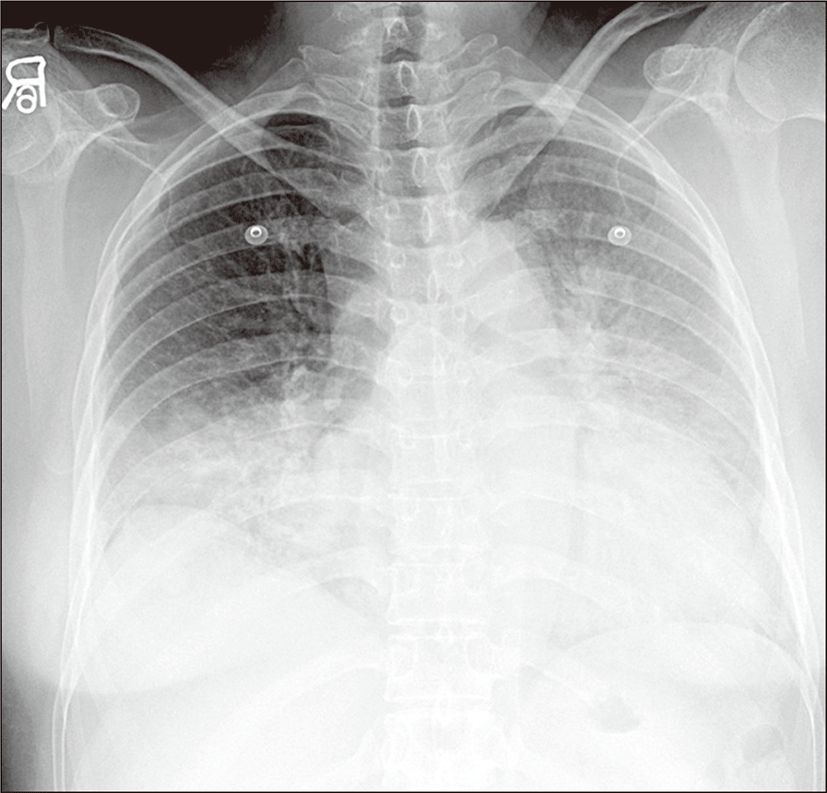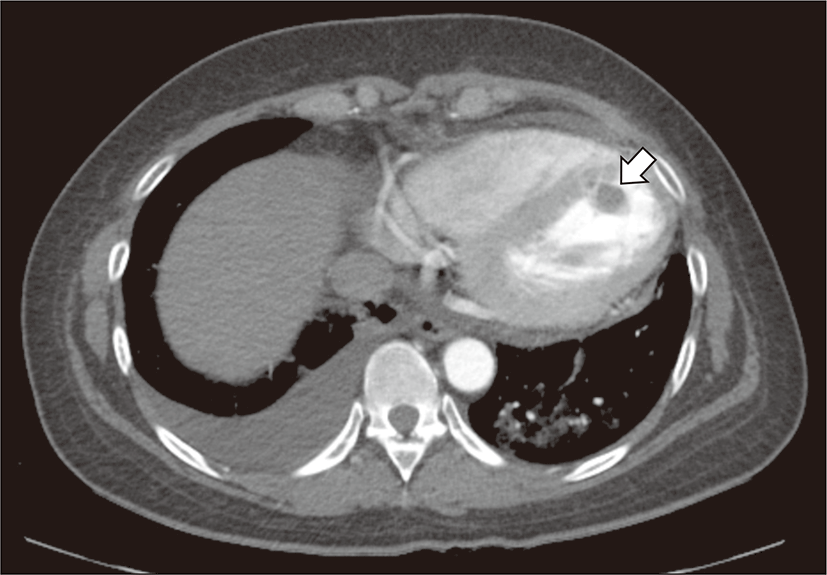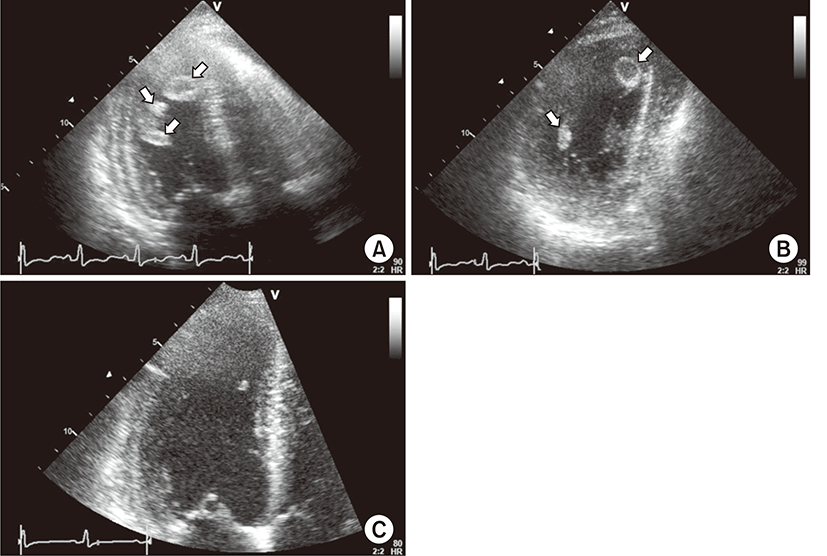Introduction
Obesity has become one of the main health issues, and various attempts to reduce weight have been tried. Many people take drugs that suppress appetite and the absorption of food and increase the metabolic rate. However, some of these drugs have unpredictable complications, including cardiovascular side effects. Some legally marketed amphetamine-like drugs such as fenproporex and diethylpropione are also prescribed for weight reduction for their appetite reduction effect, but these drugs share the side effects of amphetamines [1]. There are multiple reported cases of acute myocardial infarction and stroke after the use of amphetamines [2-10]. However, to our knowledge there are no published case reports of intracardiac thrombosis with an amphetamine-like drug without myocardial infarction. We report the case of a 37-year-old female presenting with a left ventricle (LV) thrombus after amphetamine intake.
Case
A 37-year-old female patient with dyspnea on exertion and peripheral edema was admitted to our hospital. For one and a half years, the patient had been taking various drugs and supplements to reduce weight such as phentermine hydrochloride, theae folium powder, orthosiphon powder, saposhnikoviae radix powder, and other herbal medicines. Two weeks before admission, a progressive cough, febrile sense, and myalgia had developed. The patient complained of dyspnea (New York Heart Association [NYHA] III~IV) and peripheral edema a week before admission. The patient had no history of hypertension, hyperlipidemia, diabetes mellitus or other cardiovascular or cerebrovascular diseases, and the patient had no family history of cardiovascular disease. She did not take oral contraceptives, but she was a current smoker with a three pack-year smoking history. At admission, her blood pressure was 100/60 mmHg, heart rate was 80 beats per minute, respiratory rate was 20 per minute and body temperature 36.9°C. The patient appeared acutely ill with an alert mental state. A crackling sound was auscultated on both lower lung fields, and her heartbeat was regular, without significant murmur. The examination of her abdomen was unremarkable; a grade IV pitting edema was observed. Her body weight had increased from 64 kg to 79.2 kg over one week. On simple chest radiography, a pulmonary edema was seen in both lung fields with cardiomegaly (Fig. 1), and an electrocardiography (ECG) showed sinus tachycardia with poor R progression on the chest lead and T wave inversion in the limb leads. Under the impression of congestive heart failure (CHF), diuretics (furosemide 20 mg/day, spironolactone 50 mg/day) and angiotensin receptor II blocker were given, and to prevent deep vein thrombosis, a half dose of low molecular weight heparin (LMWH) was injected. A chest computed tomography (CT) study showed a capsulated space-occupying lesion 1.7 cm in diameter in the LV (Fig. 2). Two-dimensional echocardiography showed reduced LV systolic function (LVEF, 30%), with moderate-to-severe global LV hypokinesis. There was no significant valvular lesion or significant LV enlargement (LV end-diastolic diameter, 54 mm). Neither right ventricular enlargement nor significant pulmonary hypertension was found (right ventricular systolic pressure, 27 mmHg).
A mobile cystic mass (1.1×1.8 cm) was attached to the septal area of the apex of the LV (Fig. 3A). Follow-up echocardiography, which was performed the next day, revealed newly developed cystic masses that were attached to the papillary muscle (Fig. 3B). With this finding, we concluded that the cystic mass was a thrombus and increased the dose of LMWH. After that, warfarin was also given. Follow-up echocardiography was done two days afterwards, and it showed improved LV dysfunction (LVEF 60%), and remarkably reduced and collapsed previous cystic mass-like lesions. On the eighth day in hospital, LV function was completely normalized, and the mass-like lesion had almost disappeared (Fig. 3C). The patient was discharged with warfarin and ARB, and followed up in out patient department without any adverse events over six months.
Discussion
Amphetamine-like medicines are popular as weight reduction drugs for their appetite suppressing effects. Amphetamines have sympathetic activators with the stimulation of α- and β-adrenergic receptors and various effects on the cardiovascular system such as hypertension and tachyarrhythmia [10]. Acute cardiomyopathy associated with amphetamines or similar drug use was also reported [11,12]. In this case, the patient presented with acute cardiomyopathy with multiple thrombi. Echocardiography revealed significantly reduced LV systolic function without aneurysmal change; therefore, besides the LV dysfunction, hypercoagulable status may have a role in the formation of multiple thrombi. Left ventricular thrombi can be developed by the stasis of blood flow associated with myocardial infarction or cardiomyopathy accompanying severe LV dysfunction, especially apical aneurysm, valvular heart disease, and endomyocardial disease. Hypercoagulable status can be associated with this complication. The incidence of LV thrombus complicating an anterior acute myocardial infarction is estimated at 5~15%, and the incidence of left ventricular thrombus complicating with dilated cardiomyopathy and congestive heart failure varies from 10% to 30% [13]. With the progress in treatment of acute myocardial infarction, this incidence may be reduced; LV dysfunction with hypercoagulable status is still one of the primary causes of LV thromboembolism. The mechanism of thrombus formation in amphetamine use is associated with catecholamine. Catecholamine is known to induce platelet activation and aggregation. Also, amphetamine stimulates release of norepinephrine and blockade of reuptake at the sympathetic synaptic receptors, resulting acute ventricular dysfunction. Therefore, high catecholamine levels after exposure to amphetamine may trigger thrombosis by acute ventricular dysfunction and hypercoagulable status [9,14]. Echocardiography is useful in the diagnosis of LV thrombus, and it appears as an echo dense mass with definite margin during the whole course of systole and diastole. Echogenicity may be homogenous, but sometimes appears with central lucency, which mimics a cystic mass [15]. We report a case of multiple thrombi with acute cardiomyopathy after long-term treatment with a weight reduction drug that was successfully treated with conventional heart failure medication and anticoagulation. Amphetamine use is illegal in most countries, but amphetamine-like drugs are widely used legally that can share its cardiovascular complications. When we use these drugs, more attention should be paid to the cardiovascular complications.




